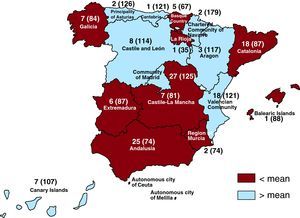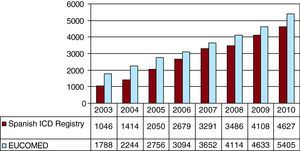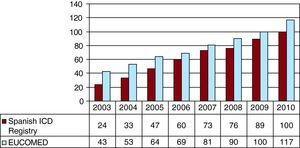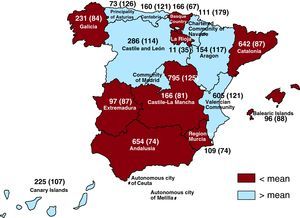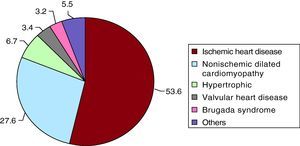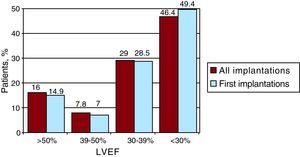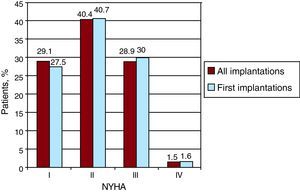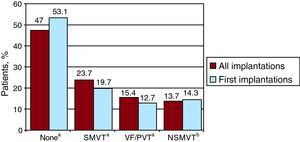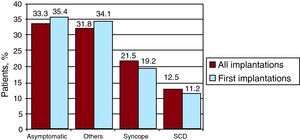The authors summarize the findings of the Spanish Implantable Cardioverter-Defibrillator Registry for 2010 compiled by the Spanish Society of Cardiology Working Group on Implantable Cardioverter-Defibrillators.
MethodsMembers of the Spanish Society of Cardiology were prospectively surveyed; data were recorded voluntarily by each implantation team on one-page questionnaires.
ResultsIn total, 4627 device implantations were reported, comprising 85.6% of the overall estimated number of implantations. The reported implantation rate was 100.61 per million population and the estimated total implantation rate was 117.50 per million. The proportion of first implantations was 73.87%. We collected data from 143 hospitals (9 more than in 2009). The majority of the implantable cardioverter-defibrillator implantations were performed in men (81%). The mean age was 62.5±13 years. Most of the patients had severe or moderate-to-severe ventricular dysfunction and were in New York Heart Association functional class II. Ischemic heart disease was the most frequent underlying cardiac condition, followed by dilated cardiomyopathy. The number of implantable cardioverter-defibrillator implantations indicated for primary prevention increased over the previous year and now accounts for 65.6% of first implantations. In all, 76.1% of the implantable cardioverter-defibrillator implantations were performed by cardiac electrophysiologists.
ConclusionsThe 2010 Spanish Implantable Cardioverter-Defibrillator Registry includes data on almost 86% of all the implantable cardioverter-defibrillator implantations performed in Spain. Although the number has continued to increase, it still remains far lower than the European average. There has been a significant increase in the number of implantations indicated for primary prevention.
Keywords
.
INTRODUCTIONThe implantable cardioverter-defibrillator (ICD) has been shown to be effective in the primary and secondary prevention of sudden cardiac death (SCD). The results of a number of published studies have made it possible to establish the main indications for ICD implantation, compiled in the clinical guidelines for the management of patients with ventricular arrhythmias or at risk for SCD.1, 2 However, the increased use of these devices has raised questions concerning their efficacy outside the context of clinical trials, the appropriate selection of patients for ICD implantation, access to this therapy, its safety, and its cost-effectiveness.3 In this respect, given the limited information in the literature concerning these issues and the application of the clinical guidelines in unselected patient populations, health registries may prove to be highly useful.
The present report brings together data on ICD implantation from the Spanish ICD Registry for 2010. It is the result of the collaboration of most of the Spanish centers that implant these devices. Like the official reports that described the activity of the previous years,4, 5, 6, 7, 8, 9 this report has been prepared by members of the Working Group on ICD (GTDAI) of the Electrophysiology and Arrhythmia Section (SEA) of the Spanish Society of Cardiology (SEC).
The main objective of the registry is to enable the examination of key aspects of the current use of the ICD in Spain such as indications, clinical characteristics of the patients, implantation parameters, types of devices and their programming, and procedural complications.
METHODSThe registry data were obtained from a data collection form that is available at the SEC web page (http://www.secardiologia.es/images/stories/file/arritmias/registros-arritmias-hoja-datos-dai.pdf). The form was completed directly and voluntarily by each implantation team, with the collaboration of personnel from the manufacturer of the ICD, during or after implantation of the device and was sent by fax or e-mail to the SEC.
The information was entered into the Spanish ICD Registry by a person engaged for that purpose, with the aid of a computer specialist from the SEC and a member of the GTDAI, who were also in charge of data cleaning. The authors of this article were responsible for data analysis and the preparation of this manuscript.
The census data used to calculate the rates per million population, for the country as a whole and for each autonomous community and province, were obtained from the estimates reported by the Spanish National Institute of Statistics for the period up to 1 January 2010.10 For the populations of the European countries included, the figures of the U.S. Census Bureau were employed.11
To estimate the representativeness of the registry, we calculated the proportion of implantations and replacement procedures reported in relation to the total number of implantations and replacement procedures performed in Spain in 2010. This number was based on the data for that year provided to the European Medical Technology Industry Association (EUCOMED) by the commercial ICD suppliers in Spain.12
When more than one type of medical condition or clinical arrhythmia was reported for the same patient, only the most serious condition was included in the analysis.
The percentages for each of the variables analyzed were calculated on the basis of the total number of implantations for which information on that variable was available.
Statistical AnalysisThe numerical results are expressed as the mean±standard deviation or median [interquartile range], depending on the distribution of the values of the variable. The comparison of the continuous quantitative variables was performed using ANOVA or the Kruskal-Wallis test. The qualitative variables were compared by means of the χ2 test. The relationships between the number of implantations and the number of implantation centers per million population and between the total number of implantations and the number of implantations for primary prevention in each center were assessed using linear regression analysis. The statistical significance of the progressive increase in the proportion of ICD implantations indicated for primary versus secondary prevention was also analyzed.
RESULTSThe response rate for the different items in the data collection form ranged between 57.6% (functional status of the original electrodes in the case of replacements) and 99% (name of implantation center), although for most of the items the response rate was higher than 80%.
Implantation CentersIn all, 145 centers in which ICD implantation was performed made their data available to the registry (9 more than in 2009) (Table 1). Of these, 86 were public hospitals or clinics (6 more than in 2009). Figure 1 shows the total number of ICD implantation centers in each Spanish autonomous community and the number of implantations per million population performed in those centers that provided data to the registry in 2010.
Table 1. Number of Implantations Reported to the Registry in 2010, Classified According to Autonomous Community, Province, and Center.
| Andalusia | Implantations, no. | |
| Almeria | Hospital Torrecárdenas | 15 |
| Cadiz | Hospital Universitario Puerta del Mar | 34 |
| Cordoba | Hospital Cruz Roja | 2 |
| Hospital Reina Sofía | 47 | |
| Granada | Hospital Nuestra Sra. de la Salud | 1 |
| Hospital Clínico Universitario San Cecilio | 11 | |
| Hospital Universitario Virgen de las Nieves | 94 | |
| Huelva | Hospital Juan Ramón Jiménez | 46 |
| Malaga | Clínica de la Encarnación | 2 |
| Clínica El Ángel | 2 | |
| Clínica Parque San Antonio | 7 | |
| Clínica Santa Elena | 1 | |
| Hospital General | 2 | |
| Hospital Internacional Xanit | 5 | |
| Hospital USP de Marbella | 3 | |
| Hospital Virgen de la Victoria | 198 | |
| Seville | Clínica de Fátima | 1 |
| Clínica Sagrado Corazón, S.A. | 1 | |
| Clínica Santa Isabel | 2 | |
| Hospital Infanta Luisa (Clínica Esperanza de Triana) | 2 | |
| Hospital Nisa Aljarafe | 1 | |
| Hospital Nuestra Sra. de Valme | 46 | |
| Hospital San Agustín | 1 | |
| Hospital Virgen del Rocío | 67 | |
| Hospital Virgen Macarena | 63 |
| Aragon | ||
| Zaragoza | Hospital Universitario Lozano Blesa | 42 |
| Hospital Miguel Servet | 109 | |
| Hospital Quirón | 3 |
| Principality of Asturias | ||
| Oviedo | Hospital Begoña de Gijón | 1 |
| Hospital Central de Asturias | 159 |
| Canary Islands | ||
| Las Palmas | Clínica Santa Catalina, S.A. | 1 |
| Hospital Doctor Negrín | 40 | |
| Hospital Insular de Gran Canaria | 49 | |
| Tenerife | Clínica Santa Cruz | 2 |
| Hospital Nuestra Sra. de La Candelaria | 48 | |
| Hospital Universitario de Canarias | 84 | |
| USP Hospital La Colina | 1 |
| Cantabria | ||
| Santander | Hospital Universitario Marqués de Valdecilla | 73 |
| Castile and León | ||
| Avila | Hospital Nuestra Sra. de Sonsoles | 22 |
| Burgos | Hospital General Yagüe | 53 |
| Leon | Hospital de León | 36 |
| Salamanca | Complejo Hospitalario de Salamanca | 65 |
| Segovia | Hospital Policlínico | 2 |
| Valladolid | Hospital Campo Grande | 5 |
| Hospital Clínico Universitario de Valladolid | 84 | |
| Hospital del Río Hortega | 19 |
| Castile-La Mancha | ||
| Albacete | Clínica Recoletas | 1 |
| Hospital General de Albacete | 29 | |
| Ciudad Real | Hospital General de Ciudad Real | 21 |
| Guadalajara | Hospital General y Universitario de Guadalajara | 29 |
| Toledo | Complejo Hospitalario de Toledo | 8 |
| Hospital Nuestra Sra. del Prado | 9 | |
| Hospital Virgen de la Salud | 69 |
| Catalonia | ||
| Barcelona | Centre Cardiovascular Sant Jordi | 11 |
| Centro Médico Teknon | 2 | |
| Centro Delfos | 1 | |
| Clínica Pilar Sant Jordi | 5 | |
| Clínica Quirón | 14 | |
| Clínica Sagrada Família | 1 | |
| Fundació de G.S. de l’Hospital de la Santa Creu i Sant Pau | 137 | |
| Hospital Clínic de Barcelona | 193 | |
| Hospital de Barcelona | 2 | |
| Hospital de Bellvitge | 88 | |
| Hospital del Mar | 11 | |
| Hospital Germans Trias i Pujol | 45 | |
| Hospital Mútua de Terrassa | 1 | |
| Hospital Sant Joan de Déu | 3 | |
| Hospital Vall d’Hebron | 95 | |
| Lleida | Hospital Universitario Arnau de Vilanova | 19 |
| Tarragona | Hospital de Sant Pau i Santa Tecla | 2 |
| Hospital Universitario de Tarragona Joan XXIII | 12 |
| La Rioja | ||
| La Rioja | Hospital San Pedro | 11 |
| Valencian Community | ||
| Alicante | Clínica Benidorm | 7 |
| Hospital Clínico San Juan | 21 | |
| Hospital de Torrevieja | 35 | |
| Hospital del Vinalopó | 3 | |
| Hospital General Universitario de Alicante | 142 | |
| Sanatorio Perpetuo Socorro | 1 | |
| Castellon | Hospital de la Plana | 7 |
| Hospital General de Castelló | 47 | |
| Hospital Rey Don Jaime | 1 | |
| Valencia | Grupo Hospitalario Quirón, S.A. | 3 |
| Hospital Casa de Salud | 1 | |
| Hospital Clínico Universitario de Valencia | 74 | |
| Hospital de Manises | 9 | |
| Hospital General Universitario de Valencia | 72 | |
| Hospital Lluís Alcanyís | 11 | |
| Hospital Universitario Dr. Peset | 33 | |
| Hospital Universitario La Fe | 138 |
| Extremadura | ||
| Badajoz | Clínica de Badajóz (Clideba) | 4 |
| Hospital de Mérida | 3 | |
| Hospital Infanta Cristina | 69 | |
| Caceres | Clínica San Francisco | 4 |
| Complejo Hospitalario de Cáceres | 1 | |
| Hospital San Pedro de Alcántara | 16 |
| Galicia | ||
| A Coruña | Clínica La Rosaleda | 3 |
| Complejo Hospitalario Universitario A Coruña | 126 | |
| Complejo Hospitalario Universitario de Santiago | 69 | |
| Hospital Clínico de Santiago de Compostela | 3 | |
| Pontevedra | Complejo Hospitalario Universitario de Vigo (CHUVI) | 26 |
| Hospital do Meixoeiro | 2 | |
| Hospital Miguel Domínguez | 2 |
| Balearic Islands | ||
| Baleares | Clínica Juaneda | 5 |
| Clínica Rotger Sanitaria Balear, S.A. | 3 | |
| Hospital Son Dureta (ahora Hospital Son Espases) | 60 | |
| Hospital Son Llàtzer | 27 | |
| Policlínica Miramar (AMEBA, S.A.) | 1 | |
| Hospital Universitari Son Espases | 1 |
| Community of Madrid | ||
| Clínica de San Camilo | 2 | |
| Clínica La Luz | 5 | |
| Clínica Nuestra Sra. de América | 11 | |
| Clínica Puerta de Hierro | 169 | |
| Clínica Ruber | 2 | |
| Fundación Hospital Alcorcón | 12 | |
| Fundación Jiménez Díaz. Clínica Nuestra Sra. de la Concepción | 37 | |
| Hospital 12 de Octubre | 91 | |
| Hospital Central de la Defensa | 8 | |
| Hospital Clínico San Carlos | 107 | |
| Hospital de Fuenlabrada | 12 | |
| Hospital de Madrid | 4 | |
| Hospital de Madrid-Montepríncipe | 3 | |
| Hospital General Universitario Gregorio Marañón | 112 | |
| Hospital Infanta Elena | 4 | |
| Hospital Madrid Norte Sanchinarro | 5 | |
| Hospital Quirón Madrid | 7 | |
| Hospital Ramón y Cajal | 81 | |
| Hospital Ruber Internacional | 3 | |
| Hospital San Rafael | 1 | |
| Hospital Sanitas La Moraleja | 1 | |
| Hospital Severo Ochoa | 13 | |
| Hospital Universitario de Getafe | 17 | |
| Hospital Universitario La Paz | 84 | |
| Hospital Virgen de la Paloma | 1 | |
| Sanatorio Nuestra Sra. del Rosario | 1 | |
| Sanatorio San Francisco de Asís | 2 |
| Region of Murcia | ||
| Hospital Rafael Méndez | 15 | |
| Hospital Universitario Virgen de la Arrixaca | 94 |
| Chartered Community of Navarre | ||
| Clínica Universitaria de Navarra | 87 | |
| Hospital de Navarra | 24 |
| Basque Country | ||
| Alava | Hospital Txagorritxu | 64 |
| Vizcaya | Clínica Vicente San Sebastián | 2 |
| Hospital de Basurto | 47 | |
| Hospital de Cruces | 51 | |
| Hospital de Galdakao-Usansolo | 2 |
Figure 1. Number of implantation centers (rate per million population) in each Spanish autonomous community in 2010.
Total Number of ImplantationsIn all, 4627 implantations (first implantations and replacements) were included in the registry for 2010. This represents 85.6% of the total of 5404 ICD implantations that, according to EUCOMED data, were performed that year in Spain. Figure 2 shows the total number of implantations reported to the registry and the overall number performed, as estimated by EUCOMED, for each of the last 8 years.
Figure 2. Total number of implantations reported to the registry and that estimated by the European Medical Technology Industry Association from 2003 to 2010. EUCOMED, European Medical Technology Industry Association; ICD, implantable cardioverter-defibrillator.
The total number of ICD implantations per million population reported to the registry in 2010 was 100. According to EUCOMED data, the overall number of implantations performed per million population was 117. Figure 3 indicates the increase in the number of implantations per million population reported to the registry and in that estimated by the EUCOMED for the last 8 years. Table 1 shows the number of implantations reported to the registry by each implantation center in 2010. Figure 4 indicates the number of implantations performed in each Spanish autonomous community and reported to the registry in that year, and the number reported per million population. Table 2 shows the number of implantations reported to the registry according to the province and autonomous community in which the patient resided and the number per million population. Most of the implantations reported were performed in public hospitals and clinics (n=4287), a figure that represents 93.5% of those included in the registry for which data on the implantation center were available.
Figure 3. Total number of implantations per million population reported to the registry and that estimated by the European Medical Technology Industry Association from 2003 to 2010. EUCOMED, European Medical Technology Industry Association; ICD, implantable cardioverter-defibrillator.
Figure 4. Number of implantations reported to the registry and rate per million population in each Spanish autonomous community in 2010.
Table 2. Number of Implantable Cardioverter-Defibrillator Recipients and Number of Implantations per Million Population Reported to the Registry in 2010, According to Autonomous Community and Province.
| Community | Province | Patients, no. | Rate per million population |
| Andalusia | 74 | ||
| Almeria | 15 | ||
| Cadiz | 34 | ||
| Cordoba | 48 | ||
| Granada | 116 | ||
| Huelva | 46 | ||
| Malaga | 220 | ||
| Seville | 184 | ||
| Aragon | 117 | ||
| Zaragoza | 154 | ||
| Principality of Asturias | 126 | ||
| Asturias | 160 | ||
| Canary Islands | 107 | ||
| Las Palmas | 90 | ||
| Tenerife | 135 | ||
| Cantabria | 121 | ||
| Cantabria | 73 | ||
| Castile and León | 114 | ||
| Avila | 22 | ||
| Burgos | 53 | ||
| Leon | 36 | ||
| Salamanca | 65 | ||
| Segovia | 2 | ||
| Valladolid | 108 | ||
| Castile-La Mancha | 81 | ||
| Albacete | 30 | ||
| Ciudad Real | 21 | ||
| Guadalajara | 29 | ||
| Toledo | 86 | ||
| Catalonia | 87 | ||
| Barcelona | 609 | ||
| Lleida | 19 | ||
| Tarragona | 14 | ||
| La Rioja | 35 | ||
| La Rioja | 11 | ||
| Valencian Community | 121 | ||
| Alicante | 209 | ||
| Castellon | 55 | ||
| Valencia | 341 | ||
| Extremadura | 87 | ||
| Badajoz | 76 | ||
| Caceres | 21 | ||
| Galicia | 84 | ||
| A Coruña | 201 | ||
| Pontevedra | 30 | ||
| Balearic Islands | 88 | ||
| Baleares | 96 | ||
| Community of Madrid | 125 | ||
| Madrid | 795 | ||
| Region of Murcia | 74 | ||
| Murcia | 109 | ||
| Chartered Community of Navarre | 179 | ||
| Navarre | 111 | ||
| Basque Country | 67 | ||
| Alava | 64 | ||
| Vizcaya | 102 | ||
| Not reported | 45 | ||
| Total | 4627 |
This information was available in 4344 of the forms sent to the SEC (93.8%). There were 3209 first implantations, which represent 73.8% of all the implantations reported to the registry. According to the registry, there were 69.7 first implantations per million population. The number of replacement procedures performed was 1135 (26.12%).
Age and SexThe mean age±standard deviation of the patients who underwent ICD implantation or replacement was 62.5±13.4 years (range, 11 years to 89 years). That of the patients receiving a first implantation was 61.7±13.6 years. The majority of the implantations were performed in men, who accounted for 81.9% of all the implantations and 81.8% of the first implantations.
Underlying Heart Disease, Left Ventricular Ejection Fraction, Functional Class, and Baseline RhythmsThe most common underlying condition was ischemic heart disease (53.6%), followed by dilated cardiomyopathy (27.6%), hypertrophic cardiomyopathy (6.7%), and primary conduction defects (Brugada syndrome, ventricular fibrillation [VF], and long QT syndrome) (6.4%), with lower percentages of valvular heart disease and arrhythmogenic right ventricular cardiomyopathy (Figure 5).
Figure 5. Type of heart disease that indicated the need for device implantation (total number of implantations). The data are expressed as %.
Regarding left ventricular function, 49.9% of the patients who received a first ICD had a left ventricular ejection fraction (LVEF) less than 30% and 28.5% had a LVEF between 30% and 39%, while the smallest group was that formed by patients having mild dysfunction, with a LVEF between 39% and 50%. Similar proportions were found for the implantation group as a whole (Figure 6).
Figure 6. Left ventricular ejection fraction of the patients in the registry (first implantations and all implantations). LVEF, left ventricular ejection fraction. The data are expressed as %.
With respect to the New York Heart Association (NYHA) functional class, the largest group was formed by the patients in NYHA class II (40.4%), followed by the patients in NYHA classes III and I (28.9% and 29.1%, respectively), whereas there were very few patients in NYHA class IV. There were no marked differences between the patients receiving a first ICD and the overall group (Figure 7).
Figure 7. New York Heart Association functional class of the patients in the registry (first implantations and all implantations). The data are expressed as %. NYHA, New York Heart Association.
Regarding the baseline rhythm of the patients included in the registry, an item for which the response rate was 81.9%, the majority were in sinus rhythm (77.7%), 16.4% had atrial fibrillation, 4.7% had paced rhythm, and the remainder, other rhythms (atrial flutter or other arrhythmias).
Clinical Arrhythmia Requiring Implantable Cardioverter-Defibrillator Placement, Form of Presentation, and Laboratory-Induced ArrhythmiaThis information was available in 74.6% of the forms sent to the registry. Among the recipients of a first ICD, more than half (52.9%) had no documented clinical arrhythmia. This subgroup was followed in frequency by those of the patients with sustained monomorphic ventricular tachycardia (SMVT) and with nonsustained monomorphic ventricular tachycardia (NSMVT) (19.6% and 11%, respectively). In the overall implantation group, 47% of the patients had no documented arrhythmia. Statistically significant differences were observed between the first implantation group and the overall group in terms of the type of arrhythmia (P<.001), and the proportion of patients without arrhythmias was greater in the first implantation group and smaller in the SMVT group, whereas there were no significant differences (P=.07) in the NSMVT group (Figure 8).
Figure 8. Arrhythmia that indicated the need for implantation (first implantations and all implantations). NSMVT, nonsustained monomorphic ventricular tachycardia; SMVT, sustained monomorphic ventricular tachycardia; VF/PVT, ventricular fibrillation/polymorphic ventricular tachycardia. aP<.001; bP=.07.
The most common clinical presentation in both the overall group and the first implantation group was the absence of symptoms, followed by “other symptoms” and syncope. There were no statistically significant differences (P>.03) between the first implantation group and the overall group (Figure 9).
Figure 9. Clinical presentation of arrhythmia in patients in the registry (first implantations and all implantations). The data are expressed as %. SCD, sudden cardiac death.
Information on whether or not an electrophysiological study had been performed was available for 2489 recipients of a first ICD (78.1%). The study had been carried out in 340 of these patients (13% of those for whom a response to the item concerning this study had been provided). SMVT was the arrhythmia most frequently induced (49.8%), followed by VF/polymorphic ventricular tachycardia (3%). No arrhythmia was induced in 19.6% of the studies. These had been carried out mostly in patients with ischemic heart disease or dilated cardiomyopathy.
IndicationsTable 3 shows the changes in the types of heart disease, clinical arrhythmia, and presentation associated with implantation of a first ICD from 2007 to 2010. In most cases, the ICD was indicated for primary prevention (59.8%). The number of ICD implantations indicated for primary prevention continued to increase, as it has since 2003, year in which they accounted for 29%. These changes were statistically significant (P<.001) for all the series of data reported in the registry, with the exception of the findings in 2008 and 2009, when there were only slight decreases.9
Table 3. Number of First Implantations Reported Between 2007 and 2010 According to Type of Heart Disease, Clinical Arrhythmia, and Presentation.
| 2007 | 2008 | 2009 | 2010 | |
| Ischemic heart disease | ||||
| Aborted SCD | 113 (9.3) | 93 (7.5) | 111 (7.9) | 154 (10.0) |
| SMVT associated with syncope | 125 (10.3) | 126 (10.2) | 117 (8.4) | 132 (8.6) |
| SMVT without syncope | 207 (17) | 176 (14.3) | 201 (14.4) | 317 (20.7) |
| Syncope without arrhythmia | 172 (14.1) | 138 (11.2) | 121 (8.7) | 68 (4.4) |
| Prophylactic indication | 509 (41.8) | 607 (49.3) | 637 (45.9) | 642 (42.0) |
| Not reported/unclassifiable | 92 (7.5) | 92 (7.5) | 202 (14.5) | 212 (13.9) |
| Subtotal | 1218 | 1231 | 1389 | 1525 |
| Dilated cardiomyopathy | ||||
| Aborted SCD | 29 (4.8) | 38 (6.6) | 53 (5.5) | 49 (6) |
| SMVT associated with syncope | 48 (7.9) | 33 (5.7) | 61 (6.4) | 58 (7.1) |
| SMVT without syncope | 49 (8.1) | 43 (7.4) | 69 (7.2) | 136 (16.8) |
| Syncope without arrhythmia | 81 (13.4) | 74 (12.8) | 102 (10.7) | 34 (4.2) |
| Prophylactic indication | 334 (55.2) | 337 (58.3) | 440 (46.1) | 393 (48.7) |
| Not reported/unclassifiable | 64 (10.6) | 53 (9.2) | 228 (23.9) | 136 (16.8) |
| Subtotal | 605 | 578 | 953 | 806 |
| Valvular heart disease | ||||
| Aborted SCD | 12 (11.8) | 11 (12.5) | 8 (9.3) | 9 (8.3) |
| SMVT | 17 (26.5) | 25 (28.4) | 27 (31.3) | 29 (26.8) |
| Syncope without arrhythmia | 11 (10.8) | 8 (9.1) | 8 (9.3) | 4 (3.7) |
| Prophylactic indication in LVD | 49 (48) | 39 (44.3) | 28 (23.5) | 50 (46.2) |
| Not reported/unclassifiable | 3 (2.9) | 5 (5.7) | 15 (17.4) | 16 (14.8) |
| Subtotal | 102 | 88 | 86 | 108 |
| Hypertrophic cardiomyopathy | ||||
| Secondary prevention | 19 (18.6) | 29 (19.9) | 24 (14.9) | 90 (54.5) |
| Prophylactic implantation | 77 (75.5) | 99 (67.8) | 97 (60.2) | 53 (32.1) |
| Not reported/unclassifiable | 6 (5.9) | 18 (12.3) | 40 (24.8) | 22 (13.2) |
| Subtotal | 102 | 146 | 161 | 165 |
| Brugada syndrome | ||||
| Aborted SCD | 5 (6.9) | 7 (10.4) | 11 (8.4) | 17 (24.6) |
| Prophylactic implantation in syncope | 20 (27.9) | 27 (40.4) | 36 (27.6) | 18 (26.0) |
| Prophylactic implantation without syncope | 41 (56.9) | 28 (41.2) | 52 (40) | 23 (33.3) |
| Not reported/unclassifiable | 6 (8.3) | 5 (7.8) | 31 (23.8) | 11 (15.9) |
| Subtotal | 72 | 67 | 130 | 69 |
| ARVC | ||||
| Aborted SCD | 1 (3.7) | 2 (6.9) | 1 (3.8) | 4 (15.9) |
| SMVT | 13 (48.2) | 12 (41.4) | 16 (61.2) | 23 (71.8) |
| Prophylactic implantation | 11 (40.7) | 12 (41.4) | 5 (19.2) | 4 (12.5) |
| Not reported/unclassifiable | 2 (7.4) | 3 (10.3) | 4 (15.3) | 1 (3.1) |
| Subtotal | 27 | 29 | 26 | 32 |
| Congenital heart disease | ||||
| Aborted SCD | 2 (16.7) | 2 (11.1) | 4 (19) | 3 (8.1) |
| SMVT | 2 (16.7) | 5 (27.8) | 1 (4.7) | 15 (40.5) |
| Prophylactic implantation | 4 (33.3) | 10 (55.6) | 9 (42.8) | 16 (43.2) |
| Not reported/unclassifiable | 4 (33.3) | 1 (5.5) | 7 (33.3) | 3 (8.1) |
| Subtotal | 12 | 18 | 21 | 37 |
| Long QT syndrome | ||||
| Aborted SCD | 14 (46.7) | 3 (15.8) | 9 (50) | 18 (60) |
| Prophylactic implantation | 16 (53.3) | 16 (84.2) | 3 (16.6) | 6 (20) |
| Not reported/unclassifiable | 0 | 0 | 6 (33.3) | 6 (20) |
| Subtotal | 30 | 19 | 18 | 30 |
ARVC, arrhythmogenic right ventricular cardiomyopathy; LVD, left ventricular dysfunction; SCD, sudden cardiac death; SMVT, sustained monomorphic ventricular tachycardia. The data are expressed as no. (%).
The patients with ischemic heart disease constituted the largest subpopulation. In this group, ICD therapy was indicated predominantly for primary prevention (58.5%), with a slight increase with respect to 2009, when it was indicated in 56.4% of the patients.9 In 31.4% of the implantations performed for primary prevention, ICD therapy was combined with cardiac resynchronization therapy (CRT). This percentage was very similar to the 31.77% of the previous year.9 The next most frequent indication for ICD implantation was dilated cardiomyopathy and, again, in this group, it was mainly indicated for primary prevention (in 72.8% of the patients with this type of heart disease, compared to 69.4% in 2009).9 CRT was employed in 62.1% of these patients (compared to 56.2% in 2009).
With respect to less frequent types of heart disease, ICD therapy was predominantly indicated for primary prevention in hypertrophic cardiomyopathy, valvular heart disease and Brugada syndrome. In long QT syndrome, arrhythmogenic right ventricular cardiomyopathy and congenital heart disease, ICD implantation was more commonly indicated for secondary prevention.
There is a slight correlation between the total number of implantations in a given center and the percentage performed for primary prevention (r2=0.25; P=.05).
Table 4 shows the changes in the percentage rates of the indications related to the principal types of heart disease during the last 8 years.
Table 4. Changes in the Major Indications for Implantable Cardioverter-Defibrillator Placement (First Implantations, 2003 to 2010).
| Year | SCD | SMVT | Syncope | Prophylactic |
| 2003 | 13.7 | 42.8 | 14 | 29 |
| 2004 | 14.8 | 37 | 16 | 32.2 |
| 2005 | 11.1 | 34.8 | 14.6 | 39.5 |
| 2006 | 9.5 | 27 | 13.2 | 50.3 |
| 2007 | 9.9 | 25 | 14.1 | 50.7 |
| 2008 | 9.3 | 21.4 | 12.3 | 57 |
| 2009 | 9.4 | 20.8 | 13.9 | 55.9 |
| 2010 | 10.9 | 20.6 | 11.1 | 57.1 |
SCD, sudden cardiac death; SMVT, sustained monomorphic ventricular tachycardia; syncope, syncope with no electrocardiographic documentation of arrhythmia.
The data are expressed in %.
Data on the center and specialist were available in 91.2% and 89.5%, respectively, of the ICD implantations reported to the registry. In all, 70.3% of the implantations were carried out in the electrophysiology laboratory, indicating a slight increase with respect to 2009 (67%), and the remainder (29.6%) in the operating room. There are no reports of implantations performed elsewhere.
The intervention was carried out by electrophysiologists in 76.1% of the cases (72.2% in 2009), by surgeons in 17.7% (19.5% in 2009), and by other specialists in 5.1%.
Generator PositionThe generator was implanted in subcutaneous pectoral position in 91.8% of the patients, in subpectoral position in 8.59%, and in abdominal position in 0.2%. In first ICD implantations, these proportions were 93.85%, 6.07%, and 0.07%, respectively. Seven replacements and 2 first ICD were placed in the abdomen.
Device TypeWe have information on the type of device that was implanted in 89.8% of the cases. Single-chamber ICD, dual-chamber ICD and ICD-CRT devices were employed in 50.3%, 20.2%, and 28.2% of the patients, respectively. These utilization rates were 52.1%, 21.34%, and 26.52%, respectively, in 2009. When only first implants were taken into account, the rates were 51.1%, 20%, and 27.8%, respectively, and did not differ significantly with respect to the rates for first implants in 2009 (55.6%, 19.1%, and 25.2%, respectively). According to the data provided by the EUCOMED for 2010, the overall utilization rates of single-chamber ICD, dual-chamber ICD, and ICD-CRT devices were 48.9%, 16.2%, and 31.8%, respectively.
Reasons for Device Replacement. Need for Lead Changes at the Time of Generator Replacements and Use of Additional LeadsInformation on the reason for ICD replacement is available in 1147 cases (73.8%). Of these, the cause was battery depletion in 787 (86.0%) and in the remainder (14.5%) replacement was performed due to complications. Of the 121 cases of early replacement, 17.8% were carried out within the first 6 months following implantation.
Of the 1135 reports of ICD replacements, we have information on the status of the leads in 847 cases, and 123 of them (14.5%) were nonfunctioning. Lead extraction was performed in 40.9% of the cases in which this information was available.
Implantable Cardioverter-Defibrillator ProgrammingRegarding this aspect, we have information concerning 90.5% of the implantations. Antibradycardia pacing was most frequently programmed for VVI mode (50%), followed by DDD mode (25.5%), VVIR mode (10.3%), DDDR mode (9.9%), and other modes (4.9%), generally aimed at reducing ventricular pacing in dual-chamber devices (4.9%).
Using antitachycardia pacing algorithms, the device was programmed for ventricular pacing in 75.4% of the cases, for atrial pacing in 0.1%, and for a combination of ventricular and atrial pacing in 5.5%. Antitachycardia pacing was not programmed in 6.5%.
In 264 devices (6.6% of those in which information on programming for cardioversion was available), both atrial and ventricular cardioversion therapies were programmed.
ComplicationsThe registry includes the reports of 6 deaths occurring during implantation, constituting 0.13% of the registry population (0.12% in 2009). The remaining complications were 5 cases of pneumothorax, 2 cases of tamponade, and another 14 cases due to a variety of causes or of unspecified origin.
DISCUSSIONThe 2010 ICD registry continues to maintain acceptable representativeness, including more than 84.5% of all the implantations performed (85.6% in 2010). The data are a good reflection of the current situation in Spain in terms of the number of implantations, location and distribution according to communities, types of devices, indications, clinical characteristics of the patients, programming, and complications.
Comparison With Previous YearsWith respect to recent years, in 2010 there was a renewed upward trend in the number of ICD implantations performed for primary prevention, which had appeared to reach a standstill last year.
The most common cause in first ICD implantations was ischemic heart disease (53%; 51% in 2009),9 followed by dilated cardiomyopathy (27.6%; 26% in 2009). These were the indications in the great majority of the ICD-CRT implantations (83.3%).
In the last 9 years, there has been a progressive increase in the use of ICD implantation for primary prevention, linked to the publication of different clinical trials that provide further clinical evidence of the beneficial effects of this type of therapy. The Multicenter Automatic Defibrillator Implantation Trial II (MADIT II),13 published in 2002, revealed a significant increase in the number of implantations documented between 2002 and 2003. The results of the Comparison of Medical Therapy, Pacing and Defibrillation in Heart Failure (COMPANION)14 and the Sudden Cardiac Death in Heart Failure Trial (SCD-HeFT),15 between 2005 and 2006, confirmed previously published data and lent support to the use of this therapy, with or without CRT, in patients with heart failure.
At this time, the 2.6% increase in ICD-CRT implantation may have been promoted by the publication in 2009 of the Multicenter Automatic Defibrillator Implantation Trial with Cardiac Resynchronization Therapy,16 which included patients in NYHA classes I and II.
The number of ICD implantations reported in 2010, 4627, has increased with respect to 2009, although the proportion is somewhat lower (85.4% in 2010 and 88.6% in 2009), as compared with the 5404 carried out according to EUCOMED data. This difference between the number of implantations reported to the registry and the EUCOMED data has continued to maintain similar proportions over time. The number of implantation centers increased to 145 (9 more than in 2009); it should be pointed out that 70 of them reported fewer than 10 implantations and of these, 23 centers implanted only 1 device. We have 11 centers with more than 100 implantations a year. We observed no correlation between the number of implantations per hospital and the proportion that involved CRT (r2=0.27); however, there is a correlation between the number of implantations and the proportion that are indicated for primary prevention (r2=0.25; P=.05).
There have been no significant changes in terms of the epidemiological characteristics of the patients, and the data remained similar regarding age and sex. There continued to be a majority of patients with severe ventricular dysfunction and those in NYHA classes II and III.
With regard to the type of device, we observed a slight increase in the proportion of ICD-CRT implantations (27.8% in 2010 versus 25.2% in 2009) among the patients undergoing the procedure for the first time.
With respect to the setting and the attending specialist, there was a slight increase in the number of implantations carried out in arrhythmia units and in those performed by electrophysiologists with respect to 2009.
Comparison With Other CountriesThe EUCOMED data provide information on the number of implantations and the pacing mode in European countries. The mean number of ICD and ICD-CRT implantations in Europe was 258 per million population. Germany, with 464 implantations per million population, continued to be the country with the highest implantation rate, and Spain, with 116, once more was in last place among the countries that contribute data to the EUCOMED. Above average rates were found for Italy (n=347), The Netherlands (n=335), and Denmark (n=283). Below average rates were reported in Austria (n=239), Belgium (n=210), Ireland (n=179), Sweden (n=170), Switzerland (n=168), Finland (n=167), France (n=166), Norway (n=166), United Kingdom (n=158), Portugal (n=118), and Spain (n=116).
With respect to the number of ICD-CRT implantations per million population, the leaders were Italy (n=194), Germany (n=178), and The Netherlands (n=167). With a mean rate for all the participating countries of 100 implantations per million population, Spain was in last place with 38, although this was an increase with respect to 2009 (32 per million population).
The rate of ICD implantations per million population in Spain was the lowest of all the countries of the EUCOMED; this cannot be attributed to economic differences and is probably due to some aspect of the health system organization or the health culture in Spain. The comparison with Italy—a country with a comparable per capita income that shares the same Mediterranean cultural environment but nevertheless has the second highest implantation rate and the highest rate of ICD-CRT implantations—highlights these differences.
Differences Between Autonomous CommunitiesAs in previous registries, the rates of ICD implantation differ widely from one autonomous community to another. The mean rate reported in our registry is 100 implantations per million population, 117 per million population according to EUCOMED data. Above average rates are found in Chartered Community of Navarre (n=179), Principality of Asturias (n=151.2), Cantabria (n=126.3), the Community of Madrid (n=125.5), the Valencian Community (n=121.1), Aragon (n=117.3), Castile and León (n=114.4), and the Canary Islands (n=107.7). Below average rates were reported for Extremadura (n=89.5), the Balearic Islands (n=88.9), Catalonia (n=87.9), Galicia (n=84.3), Castile-La Mancha (n=81.5), Andalusia (n=79.7), the Basque Country (n=77.6), the Region of Murcia (n=74.6), and La Rioja (n=35). The differences observed in previous years persist and there is no evidence that the trend could change in the future. These wide differences between communities cannot be attributed to economic factors or even to aspects of health organization, since access to this type of treatment is universal and free of cost in Spain. The differences can be attributed, in part, to the number and level of development of the arrhythmia units in the different autonomous communities.
On the other hand, these differences also exist among the geographical regions of other countries.17, 18, 19 A number of reasons for this circumstance have been proposed, such as the degree of inaccessibility to the healthcare system, the social perception of sudden death, the incidence of sudden death and of ischemic heart disease in the general population, the degree of acceptance of the results of clinical trials and of clinical practice guidelines, the level of education of the population, the shortage of electrophysiologists, and evidently, causes related to the economic situation and the healthcare model currently prevailing in the country.
LimitationsThe number of implantations reported to the registry constitutes nearly 86% of those performed in Spain, according to data afforded by the EUCOMED. This figure is lower than the 90% reached in 2007, although it can be considered to be fairly representative of the true situation in Spain. On the other hand, the information provided on the data collection form was incomplete and the response rate to some of the questions was low. These two circumstances should be taken into account when it comes to interpreting the results of the registry, especially with respect to the differences in the numbers of implantations performed in each autonomous community since, as in previous years, the proportion of these procedures reported by some hospitals that are highly active in implantation was low. Nevertheless, the number of centers in which this occurred is small.
Finally, only those complications that arose during implantation were reported and, thus, those that developed or were detected soon after, such as heart failure, hematomas, lead displacement, and pneumothorax, are not included.
Future Prospects for the Spanish Implantable Cardioverter-Defibrillator RegistrySince the end of 2010, a fellow from the SEA of the SEC has been in charge of the maintenance of the registry data. At the beginning of 2011, the ICD registry data collection form was modified in order to modernize the items and make them more relevant, and additional items were added to provide more information to the registry. These factors will help to improve the Spanish ICD Registry.
The next step will be to undertake changes in the registry that include direct online completion of the data collection form, together with direct access of each center to its own data and the results of the analysis of these date. It would also be useful to include the most basic and, at the same time, most relevant aspects for a longitudinal evaluation of the outcomes, such as mortality, therapies during patient follow-up, and complications, that would be facilitated by online access. This has been shown to be possible in certain registries, like the Ontario ICD Database,20 and has recently been implemented, although only in part, in the Get With the Guidelines-Heart Failure Registry in the United States21 and the national survey on heart rhythm devices in the United Kingdom.22
CONCLUSIONSThe 2010 Spanish National ICD Registry has recorded 85.6% of the ICD implantations performed in Spain and continues to be representative of the use of and indications for this therapy in our country. The number of implantations reported to the registry has continued to increase, reaching a rate of 100 implantations per million population. There has been a significant increase in the number of ICD implantations for primary prevention, which constitute 59.8% of all the first implantations performed. As in previous years, the number of implantations in Spain continues to be markedly lower than the mean in the most advanced countries of the European Union, and considerable differences remain in the numbers of implantations reported to the registry by the different autonomous communities.
CONFLICTS OF INTERESTDr. Alzueta has received research grants from Medtronic, Boston Scientific, and St. Jude Medical, as well as fees for participating in round tables sponsored by Medtronic, St. Jude Medical, Boston Scientific, and Biotronik.
Acknowledgments
We would like to thank all the health care professionals involved in performing ICD implantations in Spain who have voluntarily and generously reported data to the registry.
We are also grateful to the individuals from the ICD manufacturers (Medtronic, Boston Scientific, St. Jude Medical, Biotronik, and Sorin Group) for their collaboration in the data collection and for returning the data collection forms corresponding to most of the implantations to the SEC.
We would also like to thank the SEC and, in particular, Gonzalo Justes and José María Naranjo, for their invaluable work in the introduction of the data and maintenance of the registry database.
Received 27 July 2011
Accepted 4 August 2011
Corresponding author: Unidad de Arritmias, Servicio de Cardiología, Hospital Universitario Virgen de la Victoria, Campus de Teatinos s/n, 29010 Málaga, Spain. jalzueta@telefonica.net
